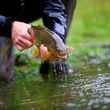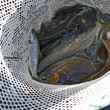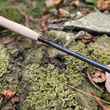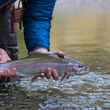Some years back, I had the opportunity to fly fish for trophy northern pike on Reindeer Lake, a massive and unspoiled boreal lake that straddles the border of Saskatchewan and Manitoba. We hit the lake right around the summer solstice — the ideal time for trophy pike in the northern reaches of Canada’s southern provinces. We arrived during a short cold snap that quickly retreated and spent a week watching the lake go from spring to summer in just a matter of days.
Fishing was good. Really good.
Over the course of the first few days, the lake’s aggressive pike were happy to take just about anything we threw at them. Long, swimmy streamers just under the surface elicited violent takes and the big fish couldn’t ignore a popper or a noisy gurgler. It got so crazy there for a while that I watched a fishing buddy of mine release a 35-inch pike only to have the released fish grabbed by a massive northern that came out of nowhere and damn near took a few fingers off as it t-boned the smaller fish.
It was one of those trips where it seemed nothing could go wrong.
Solving the puzzle
That is, until, on the last day, everything stopped. Nothing we threw worked. We asked our native First Nations guides what was up and the answers were varied. Usually, we were told, by the end of June, things warm up enough that the fish start to move out of the weed beds and head a little deeper to find cooler water. Or, as one of our guides put it, “The fish aren’t here.”
More Like This
Over the course of the week, I’d noticed that many of the really big pike — and we managed to catch some very nice fish — came to hand with a few small leeches attached to them. The blood-suckers tended to latch on to the pike just below the gills in the softest flesh they could find.
So, as the fishing slowed to a crawl, I dug into my fly box and moved past all the six-inch streamers, bouncy gurglers and gaudy poppers and grabbed a size 8 black Slumpbuster. It was the closest thing I had to a leech pattern, and I figured, if the leeches liked the pike, there’s also a pretty good chance that the pike liked the leeches.
It didn’t take long before I’d caught two nice fish in a row, including one massive female that topped 45 inches and took a good 30 minutes to bring to hand.
A symbiotic relationship
In the years since, I’ve fished for pike about every other year or so — that just seems to be about how often I find myself along the Precambrian Shield, toting a fly rod. And, I’ve noticed, in just about every Canadian or Alaskan lake or slough, the fish I’m lucky enough to bring to hand have small black leeches glued to their underbellies. On the pike that didn’t have leeches attached, they certainly sported small white scars where the parasites had attached, sucked their fill and then detaching.
And, in just about every case where, for one reason or another, pike stopped biting, sizing down to black or purple ‘Bugger or Slumpbuster proved to be the remedy. Just as the leeches pulled life-giving blood from the apex predators of the lake, the pike, too, seemed more than willing to gobble down the small swimming worms. Whether it’s out of simple hunger or well-earned revenge is debatable (although I doubt pike have a developed sense of vengeance — when they’re eating, they always seem like they’re trying to settle some score or another).
The ultimate backup plan
I’ve had small leech patterns save days on pike lakes that might otherwise have been lost causes. On a big lake in northern Manitoba in 2018, weather moved in and my son and I were forced to cast to pike in sideways rain that eventually turned into stinging ice pellets. When the pike stopped hitting the long, wispy streamers the guides recommended, I switched a sink-tip line and a size 8, jet-black Woolly Bugger.
Within a few casts, I’d salvaged the day that, honestly, would have ended early with me and my son jockeying for position around the wood stove back at the lodge. The black streamer just kept eliciting violent takes, and we braved the squall for two more hours before Cameron finally gave in and said, “I can’t feel my toes, Dad. We gotta quit.”
Not long after “discovering” that pike eat leeches, and while I was on a three-month road trip through Canada and Alaska, I stopped at a gorgeous little slough near Tok Junction. Initially, I figured I’d be fishing for Arctic grayling, but after discovering pike in the froggy water, I cut back my leader to about 30-pounds and tied on a size 10 black ‘Bugger. I was outgunned, to be sure — I was casting a 3-weight — but I managed to catch some really nice pike, including one that topped 30 inches and gave me all I could handle on the little rod.
Finally, after the last pike sliced the leader with its razor-lined jaws and took my last streamer, I had to concede and wander back to the truck.
Just last summer, while fly fishing out of Royal Wolf Lodge in Bristol Bay, I went out with the lodge’s chef and one of the guides one evening after dinner. In the land of the midnight sun, we managed to nail a handful of really nice pike in the shallow lake below the lodge, and then, for seemingly no reason at all, the pike just stopped eating.
I tied on a small black ‘Bugger, and, within minutes, we were back in business, catching pike until our arms ached. The next day, the lodge’s menu featured absolutely delectable pike sliders for evening appetizers. Win-win, right?

Later last summer, during an ill-fated trip to Labrador to chase brook trout, we were forced to adjust our target to pike after water temperatures soared into the mid-70s during the day and the brookies never bothered to show up.
But the pike were there, and, again, the venerable black Woolly Bugger was the fly of the trip.
Don’t overthink it
Yeah, pike eat like no other freshwater predator, and it’s really cool when they nail a popper or a gurgler or when they scream out the depths and absolutely devour a streamer stripped just under the surface. They are the ultimate opportunists, and I believe they are unfortunately disrespected by fly fishers.
But, as fly fishers, we must rely on a few simple rules, right? And one of those rules, no matter where you’re fishing or what you’re fishing for is tried and true: match the hatch.
Later this spring, I’m hosting a group of anglers on a pike trip to the southern Yukon, and, in addition to all the swimmy and obnoxious pike flies I’m advising my group to tie in advance of the trip, I’m also asking each of them to size down and tie a dozen or so black ‘Buggers and Slumpbusters.
When the big fluffy stuff stops working, or when the poppers don’t elicit the violent explosions they once did, go with what’s actually in the water all the time. In most northern lakes, leeches swim. And pike will eat them. I guarantee it.
































Comments
Geoff Roznak replied on Permalink
Cool story, and you're spot on about pike eating leeches...but I always cringe when people don't use enough rod for esox.
Both pike and musky are as sensitive to water that's too warm as trout are, and they build up fatal levels of lactic acid faster.
I fish for pike and musky a lot; they are not fish that fight long fights like trout, salmon, steelhead, etc...so I am wondering how heavy the rod was that it took 30 minutes to land a 45" fish.
Fish that size are uncommon - we catch a few a year here (mostly musky) and while the eats and initial action are utter chaos...the fights never last more than a few minutes.
I almost didn't post this because it sounds to much like criticism - it's not - but came back and put it up because using enough rod really matters with esox - and even more with bigger fish - if we want them to survive.
Pages